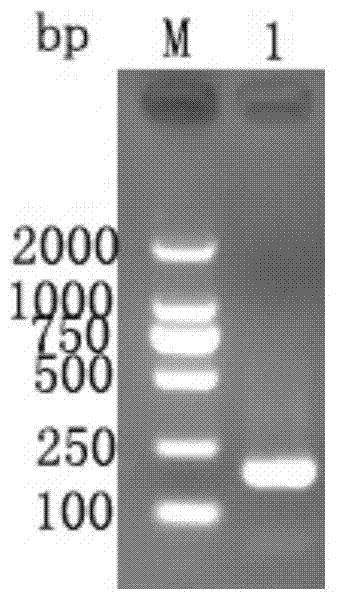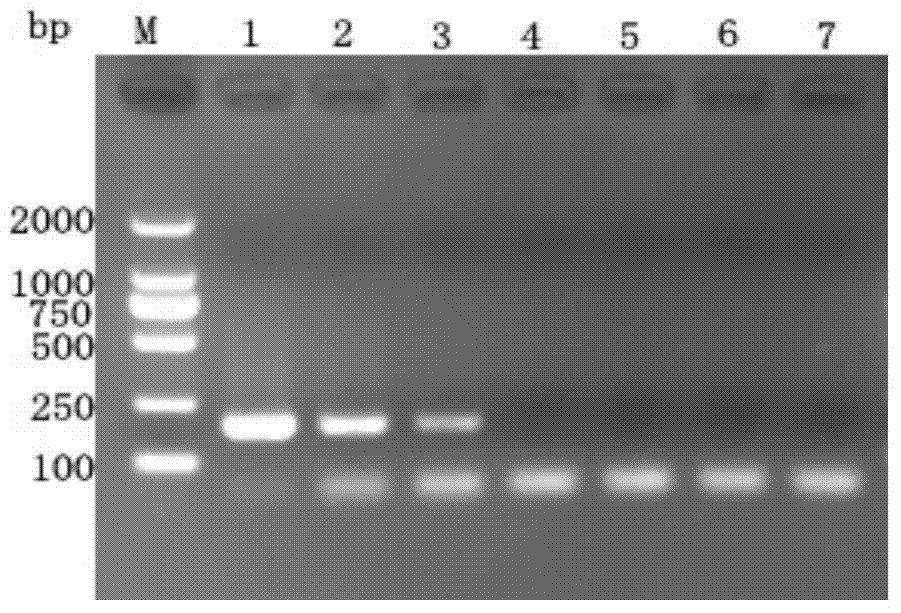Reagent kit for detecting peste des petits ruminant vaccine poison by pyrophosphoric acid sequencing technology
A technology for pyrosequencing and Peste des petits ruminants, which is applied in the field of pyrosequencing, and achieves the effects of short time consumption, convenient construction of standardized operation procedures, and small sample volume.
- Summary
- Abstract
- Description
- Claims
- Application Information
AI Technical Summary
Problems solved by technology
Method used
Image
Examples
Embodiment 1
[0036] Example 1 Design of primers for detection of Peste des petits ruminants vaccine virus
[0037] By comparing and analyzing the PPRV N gene sequences published in the NCBI Gene Bank (GenBank) of the National Center for Bioinformatics in the United States, the specific sequence of the N gene of the Ⅱ series vaccine strain (Nigeria75 / 1 strain) is determined to be 1~ 250bp gene, according to the specific sequence, use Assay Design SW software to design specific RT-PCR primers and pyrosequencing primers, select the primer set with a higher score for Blast analysis, and select a set of optimal primers for subsequent RT based on the analysis results - PCR and sequencing work.
[0038] According to the specific region sequence of Peste des petits ruminants vaccine virus N gene designed by the present invention, specific primers for the virus of Peste des petits ruminants vaccine can amplify a specific single band for the virus RNA of Peste des petits ruminants vaccine, and the l...
Embodiment 2
[0043] Example 2 Detection of Peste des petits ruminants vaccine virus using pyrosequencing technology
[0044] 1. Extraction of RNA from Peste des petits ruminants vaccine
[0045] Using inactivated PPRV Nigeria75 / 1 vaccine virus (purchased from China Veterinary Drug Administration) as raw material, RNA was extracted by TRIZOL method. The specific steps are:
[0046] (1) Take 200uL of the supernatant of the inactivated vaccine virus culture solution and add it to a sterilized 1.5ml Eppendorf tube, then add 1.0mL Trizol, mix repeatedly, and place on ice for 5min.
[0047] (2) Add 200uL chloroform, cover the cap carefully, shake the Eppendorf tube vigorously for 15s, and let it stand at room temperature for 5min. 4°C, 12000r / min, centrifuge for 15min, the solution is divided into 3 layers, the upper aqueous phase contains RNA.
[0048] (3) Transfer the water phase to a new Eppendorf tube, add 500uL isopropanol, mix well, and place at -20°C for 15min. 4°C, 12000r / min, centri...
Embodiment 3
[0063] Example 3 Using Pyrosequencing Technology to Detect Sheep Blood Samples
[0064] Take 2 blood samples of sheep immunized with the Peste des petits ruminants vaccine, 2 blood samples of diseased sheep infected with Peste des petits ruminants virus and 2 blood samples of healthy sheep, and use the method in Example 2 to detect the samples.
[0065] 1. Extraction of RNA from sheep blood samples
[0066] The QIAGEN QLAamp Viral RNA Mini Kit (K2904) was used to extract genomic RNA from goat blood samples. The kit operation steps are as follows:
[0067] (1) Add carrier RNA to buffer AVL according to the instructions, take 560 μL buffer AVL (containing carrier RNA) into a 1.5ml centrifuge tube (the amount can be adjusted proportionally according to the actual sample volume).
[0068] (2) Add 140 μL goat blood supernatant to the centrifuge tube containing buffer AVL-carrier RNA. Vortex thoroughly for 15 seconds to ensure lysis efficiency.
[0069] (3) Stand at room temperat...
PUM
 Login to View More
Login to View More Abstract
Description
Claims
Application Information
 Login to View More
Login to View More - R&D
- Intellectual Property
- Life Sciences
- Materials
- Tech Scout
- Unparalleled Data Quality
- Higher Quality Content
- 60% Fewer Hallucinations
Browse by: Latest US Patents, China's latest patents, Technical Efficacy Thesaurus, Application Domain, Technology Topic, Popular Technical Reports.
© 2025 PatSnap. All rights reserved.Legal|Privacy policy|Modern Slavery Act Transparency Statement|Sitemap|About US| Contact US: help@patsnap.com



